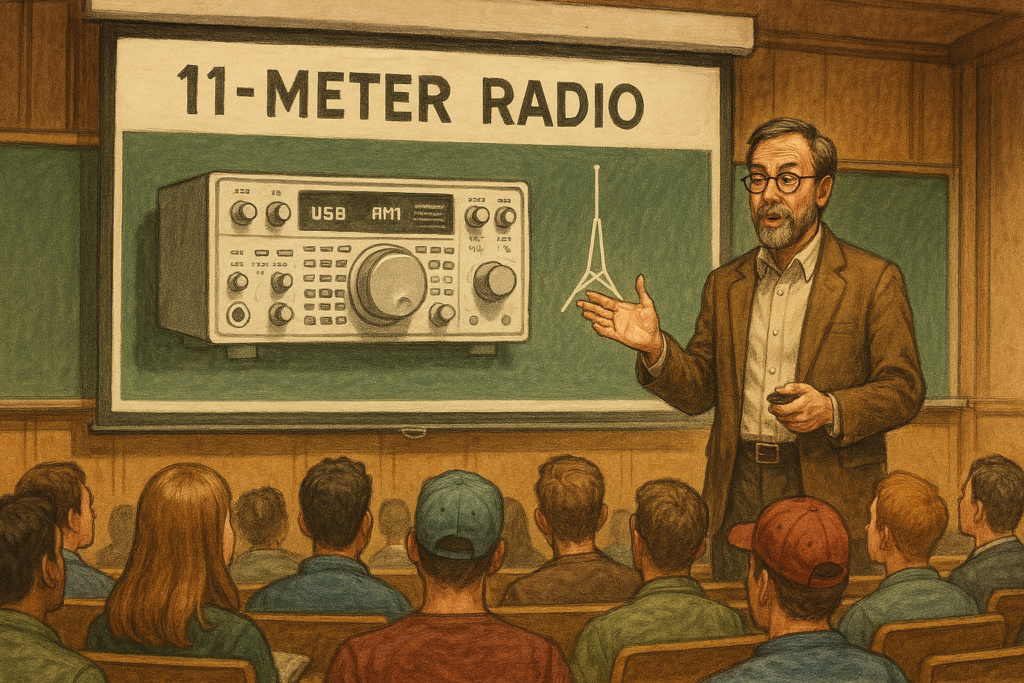
In an era brimming with endless ways to communicate—smartphones, internet messaging, social media platforms—it may sound counterintuitive to champion traditional, short-distance radio channels. Yet, the 11-meter band (often associated with Citizens Band, or CB radio) possesses distinct advantages that make it worth embracing wholeheartedly. From ease of entry to the richness of real-time, human-to-human interaction, the 11-meter community stands as a powerful reminder of what makes radio unique. As a communications professor, I find this band particularly compelling for anyone seeking a direct, communal, and straightforward way to get on the air.
1. Immediate Accessibility
One of the foremost reasons to focus on 11-meter radio is its accessibility. With most 11-meter transceivers, you can turn the radio on, adjust a few knobs, and start talking—often without needing a specialized license (depending on local regulations). This no-barrier entry is critical for inclusive communication because it invites a wide range of participants. Truck drivers, farmers, hobbyists, and curious newcomers can all share the same space with minimal red tape.
- No Ham License Required (in many regions): Obtaining an Amateur Radio (ham) license typically involves studying, taking exams, and abiding by more rigorous operating standards. While those steps cultivate expertise, they also discourage casual hobbyists who simply want to talk on the air, exchange local information, or experiment with basic radio communication.
- Minimal Setup Hassle: The typical 11-meter setup involves the radio unit, an antenna, and a power source—often simpler and cheaper compared to more elaborate, multi-band ham setups.
2. Real-Time, Human Connection
In a digital world dominated by text-based messaging and social media channels, the warm spontaneity of a voice can feel refreshing. CB radio channels on the 11-meter band facilitate real-time dialogue that tends to be unfiltered, immediate, and more personal than what you’d find in an online forum. These radio conversations:
- Build Community: Locals or passersby can participate in an ongoing conversation, offering directions, sharing weather alerts, or simply engaging in “radio chatter.” Over time, a bond forms among frequent voices on the same channel.
- Foster a Unique Radio Culture: Radio operators often develop insider jargon and codes, reinforcing group identity and a sense of belonging that is rarely matched by impersonal social media broadcasts.
3. Technical Experimentation (Without Overcomplication)
While ham radio operators often delve into advanced topics—digital modes, satellite communication, high-frequency propagation—many 11-meter enthusiasts relish the simpler pleasure of analogue experimentation. Tuning antennas for optimal signal, tweaking microphone settings, or customizing the rig can be enthralling. Because the frequency range is narrower and the technical standards are more relaxed, novices can experiment without getting overwhelmed by complex digital modes or multi-band operations.
- Hands-On Learning: Tinkering with antenna lengths, exploring propagation quirks, and learning how atmospheric conditions affect signals all become more approachable when you’re concentrating on a single band.
- Encourages Curiosity: The immediate feedback you get—static or clear signal—makes for a faster learning curve. Such real-time cause-and-effect fosters a gratifying sense of discovery.
4. Cost-Effectiveness
A noteworthy advantage of the 11-meter radio scene is the relatively low cost of entry. Vintage or modern CB radios can be found at modest prices, antennas can be homemade or purchased cheaply, and the power requirements are manageable. This affordability:
- Democratizes Participation: By lowering financial barriers, more people can engage with radio communication, allowing for a broader cross-section of society to get involved.
- Reduces Risk of “Hobby Burnout”: With a smaller initial investment, hobbyists can try out radio without feeling pressured by costly equipment. If they do decide to move on from radio, they haven’t sunk large sums of money into specialized technology.
5. Fostering Grassroots Communication
From a scholarly perspective, 11-meter radio often functions as a grassroots communication network that thrives on local context and spontaneous cooperation. Whether coordinating a local event or providing real-time traffic updates, 11-meter users can be highly responsive in localized scenarios. During emergencies, local 11-meter channels can aid in:
- Immediate Neighborhood Coordination: In the absence of cell service or internet connectivity, short-distance radio remains a practical tool for quick communication.
- Community Mutual Aid: When infrastructure fails, the locally focused nature of 11-meter channels can help neighbors check on each other and distribute essential information.
6. Preservation of Radio Traditions
As a communications professor, I see the 11-meter culture as a living time capsule that continues to evolve while still preserving core practices. The environment fosters knowledge-sharing and an appreciation for the fundamentals of voice communication. Even though many might argue that amateur radio offers more global reach and advanced techniques, the preservation of regional customs, slang, and on-air etiquette remains an asset in understanding the evolution of radio as a form of cultural expression.
- Building Radio Skills in a “Lower-Stakes” Environment: Before committing to more complex radio licenses and responsibilities, new operators can cut their teeth on the 11-meter band. Learning the “dos and don’ts” of radio communication here can be immensely valuable.
- Conduit to Future Exploration: Ironically, many 11-meter operators later choose to deepen their knowledge and branch into ham radio—yet many others remain happily and exclusively on 11 meters. Both decisions are respectable because they reflect personal comfort and community ties.
7. A High “Fun Quotient”
Finally, and perhaps most importantly, the 11-meter band is simply fun. The relaxed nature of the environment, the approachable equipment, and the lively chatter can give people a sense of fulfillment that might be lost in more formal radio services. Whether it is exchanging local weather reports, joking with a friend on another channel, or forging new acquaintances on a “skip” day when signals bounce regionally or internationally, operators often rediscover the childlike joy of discovery that radio can spark.
Conclusion
From affordability and approachability to vibrant community ties, the 11-meter band offers countless reasons for newcomers and seasoned operators alike to engage in radio communications without the barriers of licensing exams or costly equipment. It remains one of the purest forms of interactive dialogue, preserving a cherished tradition of real-time voice communication in an era saturated with digital media.
If you’re seeking a friendly, democratic, and straightforward radio experience, consider planting yourself firmly in the 11-meter realm. You will find a rich community, ample room for hands-on learning, and the excitement of participating in a living heritage of grassroots radio culture—no advanced certifications or extravagant costs required. For those of us who appreciate the immediacy, warmth, and camaraderie of direct on-air contact, the 11-meter band continues to be a uniquely rewarding place to call home


